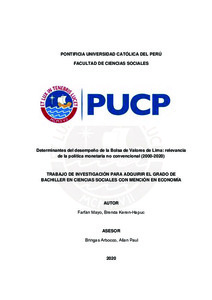| dc.contributor.advisor | Bringas Arbocco, Allan Paul | |
| dc.contributor.author | Farfán Mayo, Brenda Keren-Hapuc | |
| dc.date.accessioned | 2021-03-03T14:55:42Z | |
| dc.date.available | 2021-03-03T14:55:42Z | |
| dc.date.created | 2020 | |
| dc.date.issued | 2021-03-03 | |
| dc.identifier.uri | http://hdl.handle.net/20.500.12404/18505 | |
| dc.description.abstract | Durante mucho tiempo, los economistas financieros se han cuestionado con
respecto al desempeño que presenta el mercado bursátil peruano. La presente
investigación aborda esta interrogante examinando los principales
determinantes macroeconómicos de la variación de los índices bursátiles que
representan la evolución de la Bolsa de Valores de Lima (BVL) entre los años
2004-2020. El propósito de este estudio es evidenciar la relación pertinente que
existe entre la cartera limeña y las distintas variables macroeconómicas tales
como, los indicadores de coyuntura, exportaciones, inflación, tipo de cambio y
precio del cobre. El enfoque teórico que se pretende dar se basa en considerar
a las tasas de interés interna y externa como aquellas variables que
representan la política monetaria, la cual empleará medidas no convencionales
ante eventos de crisis, considerando la crisis sub-prime desatada en el 2008
como una de las más impactantes. Para ello, con la finalidad de demostrar la
correlación dinámica entre el mercado bursátil y las variables
macroeconómicas, se emplea el modelo de Vector Autoregresivo (VAR) y
funciones impulso respuesta (IRF). De esta forma, se contrastan resultados
significativos con el contexto y la teoría económica. | es_ES |
| dc.description.abstract | For a long time, financial economists have questioned the performance of the
Peruvian stock market. This research addresses this question by examining the
main macroeconomic determinants of the variation in stock indices that
represent the evolution of the Lima Stock Exchange (BVL) between the years
2004-2020. The purpose of this study is to show the pertinent relationship that
exists between the Lima portfolio and the different macroeconomic variables
such as economic indicators, exports, inflation, exchange rate and copper
prices. The theoretical approach that it intends to give is based on considering
internal and external interest rates as those variables that represent monetary
policy, which will use unconventional measures in the face of crisis events,
considering the subprime crisis unleashed in 2008 as one of the more shocking.
For this, in order to demonstrate the dynamic correlation between the stock
market and macroeconomic variables, the Vector Autoregressive (VAR) model
and impulse response functions (IRF) are used. In this way, significant results
are contrasted with the context and economic theory. | es_ES |
| dc.language.iso | spa | es_ES |
| dc.publisher | Pontificia Universidad Católica del Perú | es_ES |
| dc.rights | info:eu-repo/semantics/closedAccess | es_ES |
| dc.subject | Bolsa de valores--Perú | es_ES |
| dc.subject | Bolsa de valores de Lima | es_ES |
| dc.subject | Instrumentos financieros | es_ES |
| dc.subject | Finanzas--Perú | es_ES |
| dc.subject | Política monetaria--Perú | es_ES |
| dc.subject | Mercado de valores--Perú | es_ES |
| dc.title | Determinantes del desempeño de la Bolsa de Valores de Lima: relevancia de la política monetaria no convencional (2000-2020) | es_ES |
| dc.type | info:eu-repo/semantics/bachelorThesis | es_ES |
| thesis.degree.name | Bachiller en Ciencias Sociales con mención en Economía | es_ES |
| thesis.degree.level | Bachillerato | es_ES |
| thesis.degree.grantor | Pontificia Universidad Católica del Perú. Facultad de Ciencias Sociales | es_ES |
| thesis.degree.discipline | Ciencias Sociales con mención en Economía | es_ES |
| renati.advisor.dni | 7760022 | |
| renati.advisor.orcid | https://orcid.org/0000-0003-2434-8776 | es_ES |
| renati.author.dni | 72291851 | |
| renati.discipline | 311016 | es_ES |
| renati.level | https://purl.org/pe-repo/renati/level#bachiller | es_ES |
| renati.type | https://purl.org/pe-repo/renati/type#trabajoDeInvestigacion | es_ES |
| dc.publisher.country | PE | es_ES |
| dc.subject.ocde | http://purl.org/pe-repo/ocde/ford#5.02.01 | es_ES |





